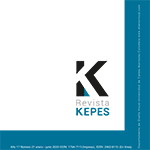Authors
Abstract
This study presents partial results of a research that explores the possibilities of coloring bamboo slats using ecologically friendly techniques. Bambusa vulgaris slats were used to perform natural dyeing processes using Curcuma longa as a natural dye. Different shades are obtained as a result of the dyeing process through the use of 3 types of mordants (potassium aluminum sulfate, iron acetate, and lye solution rich in caustic soda). Empirical evidence demonstrates natural dyeing processes of bamboo that can initially be considered as sustainable alternatives that use simple, very low-polluting and environmentally friendly techniques.
References
Chan, L.S., Cheung, W.H., Allen, S.J., and Mckay, G. (2009). Separation of aciddyes mixture by bamboo derived active carbon. Separation and Purification Technology, 67, 166-172. doi: http://10.1016/j.seppur.2009.03.020
Chan, L.S., Cheung, W.H., and Mckay, G. (2008). Adsorption of acid dyes by bamboo derived activated carbon. Desalination, 218, 304-312. doi: http://10.1016/j.desal.2007.02.026
Guan, X., Zhu, Y., and Song, W. (2016). Application of RBF neural network improved by peak density function in intelligent color matching of wood dyeing. Chaos, Solitons and Fractals, 89, 485-490. doi: http://dx.doi.org/10.1016/j.chaos.2016.02.015
Guo, M., Liu, X., and Li, Z. (2011). Studies on the Dye-uptake of Fraxinus Mandshurica Veneer with Reactive Dyes. Applied Mechanics and Materials, 44-47, 2288-2292. doi: http://10.4028/www.scientific.net/AMM.44-47.2288
Hurtado, E.A. y Arroyo, G. (2016). Teñido de fibras naturales con colorantes naturales. Jóvenes en la ciencia, Revista de Divulgación Científica, 2 (1), 1134-1138.
Kawakami, H. (2017). Tintura vegetal. Guia para treinamento minicurso 13° Colóquio de moda, 10 edição internacional. UNESP. Bauru: documento sem publicar. Universidade Estadual Paulista Júlio de Mesquita Filho, Bauru, Brasil.
Kumaresan, M. (2016). Application of eco-friendly natural dye obtained from Spathodea campanulata on silk using combination of mordants. Management of Environmental Quality: An International Journal, 27(1), 15- 21. doi: http://10.1108/MEQ-04-2015-0061
Lopes, E. (1998). Corantes naturais da flora brasileira. Guia pratica de tingimento com plantas. Curitiba: Optagraf Editora e Gráfica Ltda.
Manzini, E., and Vezzoli, C. (2002). O desenvolvimento de productos sustentáveis. Os requisitos ambientais dos produtos industriais. São Paulo, Brasil: Editora da Universidade de São Paulo.
Mayusoh, C. (2015). The art of designing, fabric pattern by tie-dyeing with natural dyes. Procedia - Social and Behavioral Sciences, 197, 1472-1480. doi: http://10.1016/j.sbspro.2015.07.097
Mirjalili, M., Nazarpoor, K., and Karimi, L. (2011). Eco-friendly dyeing of wool using natural dye from weld as co-partner with synthetic dye. Journal of Cleaner Production, 19, 1045-1051. doi: http://10.1016/j.jclepro.2011.02.001
Mohini, K., Tejashree, L., and Vijay, N. (2018). Dataset on analysis of dyeing property of natural dye from Thespesia populnea bark on different fabrics. Data in Brief, 16 (February), 401-410 doi: https://doi.org/10.1016/j.dib.2017.11.063
Mui, E.L.K., Cheung, W.H., Valix, M., and Mckay, G. (2010). Dye adsorption onto char from bamboo. Journal of Hazardous Materials, 177, 1001-1005. doi: http://10.1016/j.jhazmat.2010.01.018
Nogueira, C., Gomes, R. e Moreira, D. (2017). Os corantes naturais extraídos em São João de Côrtes, Alcântara, Maranhão: uma abordagem orientada para o design sustentável. Mix Sustentável, Florianópolis, 3(4), 93-107. doi: https://doi.org/10.29183/2447-3073.MIX2017.v3.n4.93-107
Organización de las Naciones Unidas, ONU. (1992). Declaração do Rio sobre ambiente e desenvolvimento. Conferência das Nações Unidas sobre o Meio ambiente e o Desenvolvimento (CNUMAD). Rio de Janeiro, Brasil. Disponível em: http://www.onu.org.br/rio20/img/2012/01/rio92.pdf
Peng, L., Zainab, M., Ismael, W., Songhu, Y., Man, T., Kun, W., and Jianguo, B. (2012). Adsorption of dyes from aqueous solutions by microwave modified bamboo charcoal. Chemical Engineering Journal, 195-196, 339-346. doi: http://10.1016/j.jhazmat.2010.10.012
Pereira, M. e Beraldo, A. (2008). Bambu em corpo e alma. Bauru, SP, Brasil: Canal 6.
Prabhu, K.H., and Teli, M.D. (2014). Eco-dyeing using Tamarindus indica L. seed coat tannin as a natural mordant for textiles with antibacterial activity. Journal of Saudi Chemical Society, 18, 864-872. doi: http://dx.doi.org/10.1016/j.jscs.2011.10.014
Rather, L.J., Shahid-ul-Islam, Mohd, S., Mohd, N.B., Mohd, S., Mohd, A.K., and Faqeer, M. (2016). Ecological dyeing of Woolen yarn with Adhatoda vasica natural dye in the presence of biomordants as an alternative copartner to metal mordants. Journal of Environmental Chemical Engineering, 4, 3041- 3049. doi: http://dx.doi.org/10.1016/j.jece.2016.06.019
Saravanan, P., and Chandramohan, G. (2011). Dyeing of Silk with Ecofriendly Natural Dye obtained from Barks of Ficus Religiosa L. Universal Journal of Environmental Research and Technology, 1(3), 268-273. Disponível em: https://pdfs.semanticscholar.org/606d/ed8aff00afe03b457aec64c27dffe3a8e927.pdf
Shahid A., Tahsin, G., Muhammad, A., Fazal-ur-Rehman, Muhammad, S., Iram, H., and Naeem, I. (2017). Appraisal of marigold flower based lutein as natural colourant for textile dyeing under the influence of gamma radiations. Radiation Physics and Chemistry, 130, 35-39. doi: http://dx.doi.org/10.1016/j.radphyschem.2016.07.010
Shahid, M., Shahid-ul-Islam, and Mohammad, F. (2013). Recent advancements in natural dye applications: a review. Journal of Cleaner Production, 53, 310-331. doi: http://dx.doi.org/10.1016/j.jclepro.2013.03.031
Wang, L. (2012). Application of activated carbon derived from ‘waste’ bamboo culms for the adsorption of azo disperse dye: Kinetic, equilibrium and thermodynamic studies. Journal of Environmental Management, 102, 79-87. doi: http://10.1016/j.jenvman.2012.02.019
Ya, H., He, M., Zhu, R.X., Zhang, Y.H., Yu, Y.L., and Yu, W.J. (2016). Influence of dyeing treatment on the performance of bamboo-based fibre composites. Journal of Tropical Forest Science, 28(2), 112-120. Disponível em: https://www.jstor.org/stable/43799214
Zhang, J., Xu, M., and Chen, Y. (2014). Dyeing of Bamboo Viscose Fiber with Gardenia Yellow and Sodium Copper Chlorophyll. Applied Mechanics and Materials, 670-671, 305-308. doi: http://10.4028/www.scientific.net/AMM.670-671.305
Zhang, Y., Yu, Z., and Wu, X. (2015). Comparison among Parameters Affecting Vertical Vacuum Dyeing of Populus cathayana Rehd. Forest Products Journal, 65 (3/4), 123-128. doi: http://10.13073/FPJ-D-14-00064

 PDF (Español)
PDF (Español)
 FLIP
FLIP





















